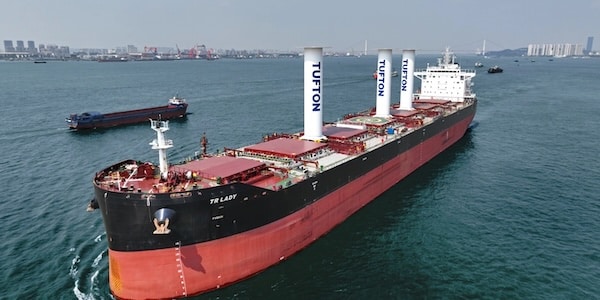How to sail through your wind-assist retrofit
Wind-Powered Bulk Carriers Set New Standards

Recent advancements in wind-assisted propulsion systems (WAPS) are transforming the shipping industry, with three notable bulk carrier projects showcasing effective rotor sail installations. Lloyd’s Register (LR) has streamlined the conversion process, ensuring compliance and efficiency, while shipowners benefit from reduced carbon emissions and fuel costs. These projects highlight the importance of early planning and collaboration in navigating the complexities of modern maritime technology.
Innovative Installations Drive Efficiency
As the demand for environmentally friendly shipping solutions rises, wind-assisted propulsion systems are becoming increasingly popular among shipowners. These systems not only enhance environmental performance but also help mitigate the financial impact of emerging carbon costs. However, the integration of new technology can present challenges, particularly when balancing lead times, yard availability, and vessel schedules. To address these issues, LR has developed a robust process for managing the complexities of rotor sail installations, ensuring that ship operators can maximize fuel savings while remaining compliant with regulations.
In collaboration with Anemoi, a leading WAPS provider, LR has successfully completed three significant installations. The Kamsarmax bulker TR Lady, fitted with Anemoi rotor sails in 2023, serves as a prime example of this partnership. Tufton Investment Management, the vessel’s owner, reported that the collaboration with LR and Anemoi minimized off-hire challenges, particularly during the COVID-19 pandemic, which disrupted supply chains. “We are encouraged by the initial results from the rotor sail operations, which show savings in line with our original expectations,” said Nicolas Tirogalas, Chief Investment Officer at Tufton. This successful installation underscores the effectiveness of LR’s approach in facilitating timely and compliant conversions.
Other notable projects include the installation of four prototype Anemoi rotor sails on the Ultramax bulk carrier Afros in 2018 and five second-generation sails on the Valemax very large ore carrier (VLOC) scheduled for October 2024. Each project has provided valuable insights into the varying requirements and deployment systems needed for different vessel types, allowing LR to refine best practices in this emerging market sector.
Streamlined Processes Enhance Compliance
The installation process for the TR Lady exemplifies how early planning can simplify complex retrofits. The ‘wind-ready’ phase, executed in November 2022, involved extensive preparatory work, including structural modifications and electrical integration, ensuring that the vessel was ready for the rotor sail installation in June 2023. This phased approach allowed for most structural work to be completed before the sails were fitted, significantly reducing the time spent in dry dock.
Compliance with regulatory standards is a critical aspect of any wind retrofit. The integration of wind-assisted propulsion systems can impact a vessel’s stability and navigational safety, necessitating careful planning and execution. For instance, the Panama Canal Authority requires specific lighting arrangements for vessels, which necessitated modifications to the TR Lady’s masthead lights to ensure compliance. Additionally, the installation of rotor sails can alter a ship’s lightweight and center of gravity, requiring inclining experiments to reassess stability. Such challenges highlight the importance of thorough preparation and collaboration among stakeholders to navigate regulatory requirements effectively.
LR’s experience with rotor sail installations has underscored the significance of cooperation between class societies, technology providers, and shipowners. By adopting a ‘wind-ready’ approach, the industry can streamline the integration of wind-assisted technologies, ultimately leading to enhanced operational efficiency and reduced environmental impact. As the shipping sector continues to evolve, these pioneering projects set a precedent for future advancements in sustainable maritime practices.
